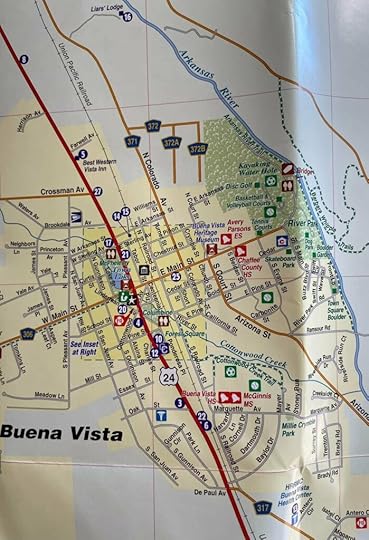The One Where Becky Learns a New Word
I love maps. If I had known the word cartographer as a kid, I might have had an entirely different career trajectory.
I’ve talked many times about my huge family and how we’d drive all over Colorado when I was growing up. What I might not have told you is that I used to get carsick on those rides. In an effort to keep me from urping on every mountain pass, my parents installed me in the coveted center of the front bench seat in the station wagon. I know! Rewarded for barfing … a dream come true. But what it really meant was that I got to hold the map and help direct Dad on our route, tracing my finger along the roads, pointing out interesting landmarks. I’m sure my siblings still discuss in reverential tones those times I’d require silence to direct their attention out the left side of the car where, just over there, was a creek/campground/town I couldn’t pronounce. Reverential, I’m sure of it.
I don’t read deeply in the fantasy genre, but I love to pore over those intricate artistic maps in the front of the books. Works of art, most of them. Every time I examine one, I wonder where in their writing process did the author think about, or finalize, their map, because I’m also fascinated with other authors’ writing processes. I pepper them with questions any chance I get, in case they do something I think might help me tweak my process.
Because I do have a process. A fairly substantial one. In fact, I wrote EIGHT WEEKS TO A COMPLETE NOVEL because people regularly ask me about my writing process.
I have certain things I always do with a manuscript, most of which I learned the hard way … you know, by NOT doing it that one time.
You might not be surprised to learn I make maps for every book—towns, office buildings, train stations, apartment interiors … all kinds of things I don’t want to have to remember.
Now that I’m starting a fairly intricate new series—fifteen books, with a huge cast of characters—I knew I had to work a tad harder on my town map than I usually do.
As much as I love maps, I typically just make a quick pencil sketch of my fictional town. And I’m no artist, so it’s very rough!
But in the case of my new Sugar Mill Marketplace series, since there are so many people and places to keep track of, I decided to step up my game and create a bona fide map of Sugar Springs, my fictional town. It’s based on a real town in Colorado, Buena Vista, but I have to take liberties to bend it to my will.

I got a map of Buena Vista and my plan was to just tape it to a window and trace what I needed. Unfortunately, my map is one of those colorful Chamber of Commerce maps with printing on both sides, so the other side bled through and I couldn’t see what I needed.
So I went to my thotful spot—my craft room—and thunk about it. I haven’t had carbon paper since about 1983, but I do keep a supply of fusible interfacing on hand. You never know when you need to fake a quick hem or something. I placed the map on a table and taped the interfacing over it and started tracing with my sharpest Sharpie.


Then I was able to tape my Sharpied interfacing to the window with a piece of paper over it and actually be able to see the lines while I traced, like I wanted to do originally with the Chamber map.


Way harder than it sounds, btw. The thing that makes fusible interfacing fusible are all the little bumps on one side that make it stick when you iron it on fabric. Not so helpful when you’re trying to trace. But finally, after much creative cursing and a forgiving Sharpie, I got it done.

I’ve already filled in some things, most importantly where the Marketplace is going to be. But also some things that I needed to know when writing the novella that bridges my Mystery Writer series with this new Marketplace series. I can’t remember if I told you or not, but one of the characters in the new series is Dena Russo, the mother of Charlee Russo from the Mystery Writer series. I needed to know where her house was, a couple of offices, the sandwich shop … that kind of thing.
As I work on each new manuscript, I’ll be able to add in the new places I need, and remind myself where everything else is situated.
I’m pleased as punch with my new map and know it will serve me well, but now I’m wondering if Ptolemy or Leonardo da Vinci used fusible interfacing as their map-making medium.
What about you … are you a cartophile? (Yes, I had to look that one up.) Do you study maps in the front of books and as you read, flip back and refer to them? Will you notice if one of my characters drives the wrong way home? Do you make maps for your own books? Do you have a stash of fusible interfacing for map-making emergencies?



